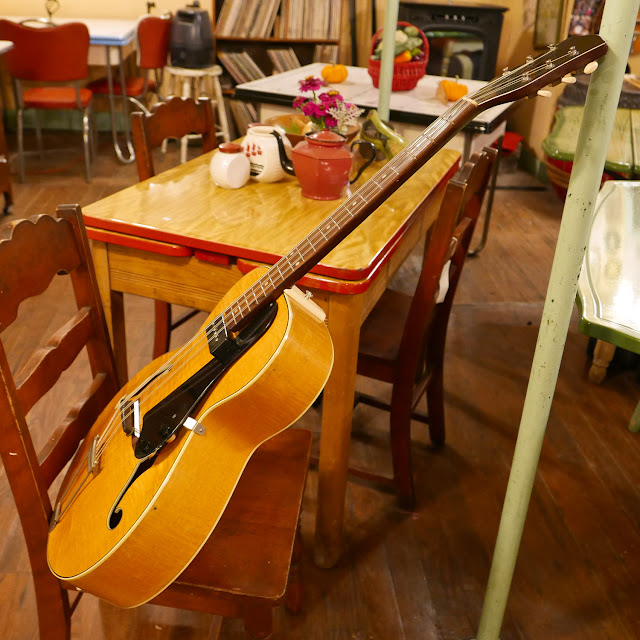1950s National New Yorker Archtop Electric Mandocello Conversion
This is the sort of thing that happens when buddies spy one another's gear collection. A customer of mine (who's just as crazy as I am) had me mod-up a '57 National Dynamic (essentially the same guitar) into a 3-course electric mandocello earlier this year. Now, 6 months later, his friend had me conjure this up. I think this is a beautiful thing -- both the proliferation of two '50s Nationals getting a new lease on life as mandocellos... and also the instrument itself!
The serial number plate on the back of the headstock is gone, but I'm guesstimating this to date from between 1953-1955 -- and while this instrument came to me bereft of a pickup and looking much like the acoustic-only "National Californian," there was definite evidence of this starting out as an electrified "National New Yorker." An extra pickguard screwhole farther down the side of the body (for the longer, New Yorker-style guard), two scuff marks below the fretboard extension, and an original ground-wire drill-hole (and spiral mark from where that ground wire sat) at the tailpiece testify to that. Because the jack would've come off of the pickguard and the early iterations of the New Yorker's pickup simply sat on the top, it was an easy-enough mod to do.
Anyhow, that made me feel less bad about cutting a big old hole in the top to install a "stacked P90" (meaning a P90 with a second coil suspended beneath to make it humbucking) pickup, drilling a jack hole in the side, wiring it up, and converting it over to this crazy, low-slung monstrosity. Other work included a fret level/dress, adjustment on the adjustable neck-angle gizmo, and making a new saddle for the top of the bridge (the original zig-zag guitar saddle is stowed safely in the case). Strings are 64w-38w-28w and I have it tuned to an open, modal, CGC tuning where the first C is two full steps below a guitar's low E.
It's a handsome guitar with that all-ply, all-flamed-maple body and two-ply thick binding -- even at the f-holes! These bodies were made by Kay and are roughly 000 in size with a 15 5/8" lower bout width as opposed to a "regular" 16" archtop width. Bracing is tonebar style.
National put their own "Sylist" necks on these (and also Gibson bodies) -- with an inner metal core and mahogany "wrapping" on their outsides. These tend to be very stable and have an ingenious bolted-on joint that allows for all sorts of neck-angle adjustments on-the-fly.
The original headstock medallion is also missing, though the original bone nut served well to sand-down and recut for this stringing. The Kluson tuners appear to be original, too.
The board is rosewood with a 12" radius. The neck has a 24 3/4" Gibson-style scale length and the neck profile is very Gibson-esque, too, with a medium, round C-shaped profile that's "home base" for my fingers.
I would've normally installed a pickup like this with a dogear cover, but that would've meant I'd need an extra spacer to kit-it-out correctly. I fit the soapbar cover you see here to the top instead as it let me get the height I needed. It also gives it a more "National" look.
This pickup is another 3/8" or so deeper than the average P90, too, being a stacked model -- so I had to do some cutting in the top and braces that necessitated reinforcement of the bracing as well. Because this installs with two, long, thin screws I also finagled a pine mounting plate to support it behind the braces. I would've taken a picture but it was too awkward to do so as I had to hold everything together. Anyhow -- I was pretty happy with the solution!
Tonewise, because this is a stacked humbucker, the pickup doesn't really sound like your average P90. It's cleaner-sounding, less aggressive, and has mellower top-end. It actually sounds a bit like a mellow FilterTron in some ways, to my ears -- or a good, clear, sweet-topped mini-humbucker.
The new bridge top compensates better for the tuning it's in. As usual, once I find the right "spot" for the bridge, I mark its location with pencil behind and to the side of the bridge... so when an overeager player smacks it, it won't be hard to relocate it.
I've always liked the simplicity of this type of tailpiece.
I used mini pots and knobs from an original '60s Japanese "add-on" archtop guitar pickup wiring harness. They fit in just right on this. I did bag up a couple of nice rosewood knobs for the owner of this rig, however, if he should decide he wants to dress it up. I liked the low profile of these tiny knobs, though. The tone pot, for whatever reason, isn't as linear as I'd like in conjunction with this pickup, but gets the job done.
Earlier this year I got serious about shielding on electric guitar projects and now whenever I work on hollowbody instruments and change the wiring, I tend to use braided-metal-wrap-grounded Gibson-style wire where possible and make sure modern plastic-coated wire (as in: the factory leads from this pickup) gets covered in copper shielding tape and properly grounded.
A lot of these mid-'50s Nationals with the adjustable heel shipped with covers that did not have a strap button integrated -- so I add them back.
If you haven't played one of these archtops (as guitars) with their almost-flush necks -- it really is a joy. I can get a barred E chord way up there without fuss.


















Comments